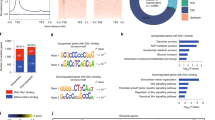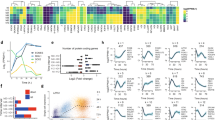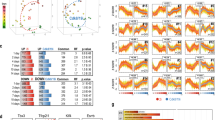Abstract
A hallmark of cancer cells is the metabolic switch from oxidative phosphorylation (OXPHOS) to glycolysis, a phenomenon referred to as the ‘Warburg effect’, which is also observed in primed human pluripotent stem cells (hPSCs). Here, we report that downregulation of SIRT2 and upregulation of SIRT1 is a molecular signature of primed hPSCs and that SIRT2 critically regulates metabolic reprogramming during induced pluripotency by targeting glycolytic enzymes including aldolase, glyceraldehyde-3-phosphate dehydrogenase, phosphoglycerate kinase, and enolase. Remarkably, knockdown of SIRT2 in human fibroblasts resulted in significantly decreased OXPHOS and increased glycolysis. In addition, we found that miR-200c-5p specifically targets SIRT2, downregulating its expression. Furthermore, SIRT2 overexpression in hPSCs significantly affected energy metabolism, altering stem cell functions such as pluripotent differentiation properties. Taken together, our results identify the miR-200c–SIRT2 axis as a key regulator of metabolic reprogramming (Warburg-like effect), via regulation of glycolytic enzymes, during human induced pluripotency and pluripotent stem cell function.
This is a preview of subscription content, access via your institution
Access options
Access Nature and 54 other Nature Portfolio journals
Get Nature+, our best-value online-access subscription
$29.99 / 30 days
cancel any time
Subscribe to this journal
Receive 12 print issues and online access
$209.00 per year
only $17.42 per issue
Buy this article
- Purchase on Springer Link
- Instant access to full article PDF
Prices may be subject to local taxes which are calculated during checkout








Similar content being viewed by others

References
Warburg, O., Wind, F. & Negelein, E. The metabolism of tumors in the body. J. Gen. Physiol. 8, 519–530 (1927).
Warburg, O. On the origin of cancer cells. Science 123, 309–314 (1956).
Rafalski, V. A., Mancini, E. & Brunet, A. Energy metabolism and energy-sensing pathways in mammalian embryonic and adult stem cell fate. J. Cell Sci. 125, 5597–5608 (2012).
Ito, K. & Suda, T. Metabolic requirements for the maintenance of self-renewing stem cells. Nat. Rev. Mol. Cell Biol. 15, 243–256 (2014).
Burgess, R. J., Agathocleous, M. & Morrison, S. J. Metabolic regulation of stem cell function. J. Intern. Med. 276, 12–24 (2014).
Zhang, J., Nuebel, E., Daley, G. Q., Koehler, C. M. & Teitell, M. A. Metabolic regulation in pluripotent stem cells during reprogramming and self-renewal. Cell Stem Cell 11, 589–595 (2012).
Folmes, C. D., Dzeja, P. P., Nelson, T. J. & Terzic, A. Metabolic plasticity in stem cell homeostasis and differentiation. Cell Stem Cell 11, 596–606 (2012).
Zhang, J. et al. UCP2 regulates energy metabolism and differentiation potential of human pluripotent stem cells. EMBO J. 30, 4860–4873 (2011).
Zhou, W. et al. HIF1α induced switch from bivalent to exclusively glycolytic metabolism during ESC-to-EpiSC/hESC transition. EMBO J. 31, 2103–2116 (2012).
Varum, S. et al. Energy metabolism in human pluripotent stem cells and their differentiated counterparts. PLoS ONE 6, e20914 (2011).
Folmes, C. D. et al. Somatic oxidative bioenergetics transitions into pluripotency-dependent glycolysis to facilitate nuclear reprogramming. Cell Metab. 14, 264–271 (2011).
Moussaieff, A. et al. Glycolysis-mediated changes in acetyl-CoA and histone acetylation control the early differentiation of embryonic stem cells. Cell Metab. 21, 392–402 (2015).
Panopoulos, A. D. et al. The metabolome of induced pluripotent stem cells reveals metabolic changes occurring in somatic cell reprogramming. Cell Res. 22, 168–177 (2012).
Kim, S. C. et al. Substrate and functional diversity of lysine acetylation revealed by a proteomics survey. Mol. Cell 23, 607–618 (2006).
Zhao, S. et al. Regulation of cellular metabolism by protein lysine acetylation. Science 327, 1000–1004 (2010).
Wang, Q. et al. Acetylation of metabolic enzymes coordinates carbon source utilization and metabolic flux. Science 327, 1004–1007 (2010).
Guarente, L. The logic linking protein acetylation and metabolism. Cell Metab. 14, 151–153 (2011).
Guarente, L. & Franklin, H. Epstein Lecture: Sirtuins, aging, and medicine. N. Engl. J. Med. 364, 2235–2244 (2011).
Finkel, T., Deng, C. X. & Mostoslavsky, R. Recent progress in the biology and physiology of sirtuins. Nature 460, 587–591 (2009).
Gatenby, R. A. & Gillies, R. J. Why do cancers have high aerobic glycolysis? Nat. Rev. Cancer 4, 891–899 (2004).
Mathieu, J. et al. Hypoxia-inducible factors have distinct and stage-specific roles during reprogramming of human cells to pluripotency. Cell Stem Cell 14, 592–605 (2014).
Prigione, A. et al. HIF1α modulates cell fate reprogramming through early glycolytic shift and upregulation of PDK1-3 and PKM2. Stem Cells 32, 364–376 (2014).
North, B. J., Marshall, B. L., Borra, M. T., Denu, J. M. & Verdin, E. The human Sir2 ortholog, SIRT2, is an NAD + -dependent tubulin deacetylase. Mol. Cell 11, 437–444 (2003).
Fathi, A. et al. Comprehensive gene expression analysis of human embryonic stem cells during differentiation into neural cells. PLoS ONE 6, e22856 (2011).
Assou, S. et al. A meta-analysis of human embryonic stem cells transcriptome integrated into a web-based expression atlas. Stem Cells 25, 961–973 (2007).
Li, Z. et al. Functional and transcriptional characterization of human embryonic stem cell-derived endothelial cells for treatment of myocardial infarction. PLoS ONE 4, e8443 (2009).
Masaki, H. et al. Heterogeneity of pluripotent marker gene expression in colonies generated in human iPS cell induction culture. Stem Cell Res. 1, 105–115 (2007).
Barrett, T. et al. NCBI GEO: archive for functional genomics data sets–update. Nucleic Acids Res. 41, D991–D995 (2013).
Calvanese, V. et al. Sirtuin 1 regulation of developmental genes during differentiation of stem cells. Proc. Natl Acad. Sci. USA 107, 13736–13741 (2010).
Lee, Y. L. et al. Sirtuin 1 facilitates generation of induced pluripotent stem cells from mouse embryonic fibroblasts through the miR-34a and p53 pathways. PLoS ONE 7, e45633 (2012).
Si, X. et al. Activation of GSK3β by Sirt2 is required for early lineage commitment of mouse embryonic stem cell. PLoS ONE 8, e76699 (2013).
Marchler-Bauer, A. et al. CDD: NCBI’s conserved domain database. Nucleic Acids Res. 43, D222–D226 (2015).
Gamblin, S. J. et al. Activity and specificity of human aldolases. J. Mol. Biol. 219, 573–576 (1991).
Zhang, J. et al. Measuring energy metabolism in cultured cells, including human pluripotent stem cells and differentiated cells. Nat. Protoc. 7, 1068–1085 (2012).
Park, K. S. et al. Transcription elongation factor Tcea3 regulates the pluripotent differentiation potential of mouse embryonic stem cells via the Lefty1-Nodal-Smad2 pathway. Stem Cells 31, 282–292 (2013).
Ivanova, N. et al. Dissecting self-renewal in stem cells with RNA interference. Nature 442, 533–538 (2006).
Mu, W. L. et al. Sox2 deacetylation by Sirt1 is involved in mouse somatic reprogramming. Stem Cells 33, 2135–2147 (2015).
Miranda, K. C. et al. A pattern-based method for the identification of MicroRNA binding sites and their corresponding heteroduplexes. Cell 126, 1203–1217 (2006).
Suh, M. R. et al. Human embryonic stem cells express a unique set of microRNAs. Dev. Biol. 270, 488–498 (2004).
Wang, G. et al. Critical regulation of miR-200/ZEB2 pathway in Oct4/Sox2-induced mesenchymal-to-epithelial transition and induced pluripotent stem cell generation. Proc. Natl Acad. Sci. USA 110, 2858–2863 (2013).
Gomes, P., Outeiro, T. F. & Cavadas, C. Emerging role of Sirtuin 2 in the regulation of mammalian metabolism. Trends Pharmacol. Sci. 36, 756–768 (2015).
Xiong, Y. & Guan, K. L. Mechanistic insights into the regulation of metabolic enzymes by acetylation. J. Cell Biol. 198, 155–164 (2012).
Xu, Y. et al. Oxidative stress activates SIRT2 to deacetylate and stimulate phosphoglycerate mutase. Cancer Res. 74, 3630–3642 (2014).
Hallows, W. C., Yu, W. & Denu, J. M. Regulation of glycolytic enzyme phosphoglycerate mutase-1 by Sirt1 protein-mediated deacetylation. J. Biol. Chem. 287, 3850–3858 (2012).
Tsusaka, T. et al. Deacetylation of phosphoglycerate mutase in its distinct central region by SIRT2 down-regulates its enzymatic activity. Genes Cells 19, 766–777 (2014).
Li, T. Glyceraldehyde-3-phosphate dehydrogenase is activated by lysine 254 acetylation in response to glucose signal. J. Biol. Chem. 289, 3775–3785 (2014).
Somers, A. et al. Generation of transgene-free lung disease-specific human induced pluripotent stem cells using a single excisable lentiviral stem cell cassette. Stem Cells 28, 1728–1740 (2010).
Takahashi, K. et al. Induction of pluripotent stem cells from adult human fibroblasts by defined factors. Cell 131, 861–872 (2007).
Kislinger, T. et al. Global survey of organ and organelle protein expression in mouse: combined proteomic and transcriptomic profiling. Cell 125, 173–186 (2006).
Zhou, J. Y. et al. Galectin-3 is a candidate biomarker for amyotrophic lateral sclerosis: discovery by a proteomics approach. J. Proteome Res. 9, 5133–5141 (2010).
Kim, D. et al. Generation of human induced pluripotent stem cells by direct delivery of reprogramming proteins. Cell Stem Cell 4, 472–476 (2009).
Acknowledgements
This work was supported by NIH grants (NS084869, NS070577, and GM101420) and the National Research Foundation of Korea (2011-0030043). The authors are grateful to members of the Kim laboratory for critical discussions.
Author information
Authors and Affiliations
Contributions
Y.C. and M.-J.H.: concept and design, collection and/or assembly of data, data analysis and interpretation, and writing. L.G., H.-J.C. and K.-S.K.: concept and design, data analysis and interpretation, and writing. J.Z., A.B., J.H.J., Y.J. and H.-C.J.: collection and/or assembly of data. C.-H.K., B.-G.K., R.L. and C.R.K.: data analysis and interpretation.
Corresponding author
Ethics declarations
Competing interests
K.-S.K. is co-founder of NurrON Pharmaceuticals and the remaining authors have no financial conflict to disclose.
Integrated supplementary information
Supplementary Figure 1 Warburg-like effect in hESCs and hiPSCs compared to hDFs.
(a) Human ESCs (H9) and hiPSCs cultured under feeder-free condition were stained with specific antibodies against pluripotency markers (e.g., Oct4, Nanog, SSEA4, and TRA1-60) along with Hoechst nuclear staining. Scale bar, 100 μm. (b) Representative pictures of hESCs and hiPSCs. Scale bar, 100 μm. (c) In vitro spontaneous differentiation of hESCs and hiPSCs by culturing in serum-free ITSFn medium for 7 days. Immunostaining images (first and second row panels) show lineage specific markers for ectoderm (Otx2), mesoderm (Brachyury; B-T), and endoderm (Sox17). Scale bar, 100 μm. (d) Intracellular ATP levels were significantly lower in hiPSCs and hESCs than in the original fibroblasts. (mean ± s.e.m., n=3 biologically independent experiments, ∗∗∗p < 0.005, two-tailed unpaired Student’s t-test). (e) Mitochondrial bioenergetics of parental hDFs and hiPSCs as well as hESCs assessed by Seahorse XF analyzer. (mean ± s.d., n=4 biologically independent experiments). (f) Expression levels of glucose transporters (GLUTs) including GLUT1 to GLUT7 in hDFs and hiPSCs as well as hESCs. (mean ± s.e.m., n=3 biologically independent experiments, ∗p < 0.05; ∗∗p < 0.01; ∗∗∗p < 0.005; ∗∗∗∗p < 0.001, one-way ANOVA with Bonferroni post-test). (g) Immunoprecipitation of hDF and hESCs proteins using antibodies against acetyl-Lys, followed by LC-MS/MS analyses to identify acetylated proteins. Statistics source data are in Supplementary Table 9. Unprocessed original scans of blots (d,g) are shown in Supplementary Fig. 9.
Supplementary Figure 2 CID spectra for the acetylated proteins shown in Supplementary Fig. 1g and Supplementary Table 1.
Peptides for tubulin, Fructose-bisphosphate aldolase, glyceraldehyde-3-phosphate dehydrogenase, phosphoglycerate kinase1, enolase, pyruvate kinase isozymes M1/M2 and ATP synthase were detected via combination of IP and LC-MS/MS analyses. IP was performed with anti-acetyl-Lys antibody.
Supplementary Figure 3 Meta-analysis of Sirtuin family expression in hESCs.
(a) Representative data showing SIRT2 expression changes between different cells. SIRT2 downregulation was observed in hPSCs compared to differentiated cells and original fibroblasts. (b–f) Mean value scatter plot of expression levels of SIRT3 (b), SIRT4 (c), SIRT5, (d) SIRT6 (e), and SIRT7 (f) in hESC lines (n=25) and normal somatic cell lines (n=15) using results from a Database search (http://www.nextbio.com). All cell lines information is shown in Supplementary Table 5. (mean ± s.e.m., two-tailed unpaired Student’s t-test).
Supplementary Figure 4 Characterization of inducible SIRT2-GFP H9 hESCs.
(a) Plasmid map of doxycycline (Dox) inducible SIRT2-EGFP overexpression vector. (b) Expression levels of pluripotency markers in wild-type hESCs, hDFs, and SIRT2-GFP hESCs with or without Dox. (mean ± s.d., n=3 biologically independent experiments, ∗∗∗p < 0.005, one-way ANOVA with Bonferroni post-test). (c) Effects of TGF-β on spontaneous differentiation of SIRT2-GFP hESCs. Cells were maintained in hESC culture conditions with or without TGF-β. TGF-β was added for 4 days and cells were immunostained for expression of the endodermal marker Sox17; Scale bar, 100 μm. (d) Expression levels of glycolytic enzymes in SIRT2-GFP hESCs with or without Dox analyzed by qRT-PCR. (mean ± s.d., n=3 biologically independent experiments, ∗∗∗p < 0.005, two-tailed unpaired Student’s t-test). Statistics source data are in Supplementary Table 9.
Supplementary Figure 5 Effects of altered SIRT2 expression on acetylation of AldoA.
(a–d) Detection of AldoA K111 (a, b) and K322 (c,d) acetylation by mass spectrometry analysis. Symbol @ indicates the acetylation site. (e) Myc-tagged AldoA, AldoAK111Q, and AldoAK322Q were each expressed in 293T cells. AldoA proteins were purified by IP with Myc antibody, and specific activity for AldoA was determined. (mean ± s.d., n=3 biologically independent experiments, ∗∗∗p < 0.005, one-way ANOVA with Bonferroni post-test). (f) Myc-tagged AldoA, AldoAK111R, and AldoAK322R were each expressed in 293T cells co-expressing SIRT2 shRNA (SIRT2KD). AldoA proteins were purified by IP with Myc antibody and specific activity for AldoA was determined. (mean ± s.d., n=3 biologically independent experiments, ∗∗∗p < 0.005, one-way ANOVA with Bonferroni post-test). Statistics source data are in Supplementary Table 9.
Supplementary Figure 6 Metabolic and functional characterization of hPSC lines following SIRT2 overexpression.
(a,c,e) Glycolytic bioenergetics of wild type (Mock) and inducible SIRT2-GFP cell lines from H7 hESCs (a) and two iPSC lines (c,e) with or without Dox were assessed by XF analyzer. (mean ± s.d., n=3 biologically independent experiments). (b,d,f) Basal glycolytic rate, glycolytic capacity and glycolytic reserve of mock and SIRT2OE from H7 hESCs (b) and two iPSC lines (d,f) with or without Dox are shown in (a, c, e), respectively. (mean ± s.d., n=3 biologically independent experiments, ∗p < 0.05; ∗∗p < 0.01, one-way ANOVA with Bonferroni post-test). (g) OCRs for two hESC lines (H9 and H7) and the hiPSC-1 line with or without Dox are shown. 1: Mock w/o Dox, 2: Mock with Dox, 3: SIRT2OE w/o Dox, 4: SIRT2OE with Dox. (mean ± s.d., n=3 biologically independent experiments, ∗p < 0.05; ∗∗∗p < 0.005, one-way ANOVA with Bonferroni post-test). (h) Cell proliferation of mock and SIRT2OE from H7 hESCs and two independent iPSC lines (hiPSC-1 and hiPSC-2) with or without Dox were analyzed by determining cell numbers every 2 days under ESC culture conditions. (mean ± s.d., n=3 biologically independent experiments, ∗∗p < 0.01; ∗∗∗p < 0.005, two-way ANOVA with Bonferroni post-test). Statistics source data are in Supplementary Table 9.
Supplementary Figure 7 SIRT2 influences metabolic signatures of early differentiation potential of hiPSCs.
(a–c) Inducible SIRT2OE hiPSC-1 cells with or without Dox were induced to differentiate spontaneously by culturing in serum-free ITSFn medium for up to 4 days, and gene expression levels of pluripotency markers (Oct4, Nanog, and Rex1) (a), early-differentiation markers (Pax6, Brachyury (B-T), and Sox17) (b) and SIRT2 (c) were determined by qRT-PCR. (mean ± s.d., n=3 biologically independent experiments, ∗p < 0.05, one-way ANOVA with Bonferroni post-test). (d) Glycolytic bioenergetics of mock and SIRT2OE hiPSC-1 cells with or without Dox were assessed using the Seahorse XF analyzer. (mean ± s.d., n=3 biologically independent experiments, ∗p < 0.05, one-way ANOVA with Bonferroni post-test). (e) Extracellular lactate production of mock and SIRT2OE hiPSC-1 cells with or without Dox. (mean ± s.d., n=3 biologically independent experiments, ∗p < 0.05; ∗∗p < 0.01, one-way ANOVA with Bonferroni post-test). (f) Heatmaps depicting gene expression levels of markers representing ectoderm (Pax6, Map2, GFAP and AADC), endoderm (Foxa2, Sox17, AFP, CK8 and CK18), and mesoderm (Msx1 and B-T) in wild type (Mock) and inducible SIRT2OE hiPSC lines including hiPSC-1 and hiPSC-2 with or without Dox for up to 12 days under differentiation conditions. (n=2 biologically independent experiments). 1: Mock w/o Dox, 2: Mock with Dox, 3: SIRT2OE w/o Dox, 4: SIRT2OE with Dox. Statistics source data are in Supplementary Table 9.
Supplementary Figure 8 Effects of altered SIRT1 expression on metabolic reprogramming and iPSC generation.
(a) Plasmid map of doxycycline (Dox) inducible SIRT1-EGFP overexpression vector. (b) OCR for hDFs infected with wild type (Mock) or inducible SIRT1-GFP (SIRT1OE) with or without Dox at day 3 post transfection. (mean ± s.d., n=3 biologically independent experiments). (c,d) OCR/ECAR ratio (c), and relative OCR changes after FCCP injection (d) from Mock and SIRT1OE with or without Dox are shown in (b). (mean ± s.d., n=3 biologically independent experiments). (e,f) Effects of SIRT1KD or OE on iPSC generation. Upper: Efficiency of SIRT1KD or OE was confirmed by western blotting with anti-SIRT1 antibody. Lower: Representative pictures of AP-positive colonies at day 14 post-transduction. (mean ± s.e.m., n=3 biologically independent experiments, ∗∗∗p < 0.005, two-tailed unpaired Student’s t-test). (g,h) OCR in hDF infected with Y4 and/or SIRT1OE at 3 (g) or 6 (h) days after transfection. (mean ± s.d., n=3 biologically independent experiments). Statistics source data are in Supplementary Table 9. Unprocessed original scans of blots (e,f) are shown in Supplementary Fig. 9.
Supplementary information
Supplementary Information
Supplementary Information (PDF 4966 kb)
Supplementary Table 1
Supplementary Information (XLSX 13 kb)
Supplementary Table 2
Supplementary Information (XLSX 11 kb)
Supplementary Table 3
Supplementary Information (XLSX 12 kb)
Supplementary Table 4
Supplementary Information (XLSX 16 kb)
Supplementary Table 5
Supplementary Information (XLSX 14 kb)
Supplementary Table 6
Supplementary Information (XLSX 9 kb)
Supplementary Table 7
Supplementary Information (XLSX 9 kb)
Supplementary Table 8
Supplementary Information (XLSX 11 kb)
Supplementary Table 9
Supplementary Information (XLSX 342 kb)
Rights and permissions
About this article
Cite this article
Cha, Y., Han, MJ., Cha, HJ. et al. Metabolic control of primed human pluripotent stem cell fate and function by the miR-200c–SIRT2 axis. Nat Cell Biol 19, 445–456 (2017). https://doi.org/10.1038/ncb3517
Received:
Accepted:
Published:
Issue Date:
DOI: https://doi.org/10.1038/ncb3517
This article is cited by
-
Mitochondrial metabolism in neural stem cells and implications for neurodevelopmental and neurodegenerative diseases
Journal of Translational Medicine (2024)
-
Mass production of lumenogenic human embryoid bodies and functional cardiospheres using in-air-generated microcapsules
Nature Communications (2023)
-
Restricting epigenetic activity promotes the reprogramming of transformed cells to pluripotency in a line-specific manner
Cell Death Discovery (2023)
-
Increased expression of 6-phosphofructo-2-kinase/fructose 2,6-bisphosphatase-3 is required for growth of mouse embryonic stem cells that are undergoing differentiation
Cytotechnology (2023)
-
Breast cancers as ecosystems: a metabolic perspective
Cellular and Molecular Life Sciences (2023)


